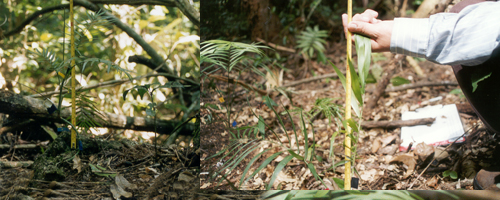Long-term performance and herbivory of tree seedlings planted into primary and secondary forests of Central Amazonia
Julieta Benítez-Malvido and Miguel Martínez-Ramos
Abstract
Plant survival and growth in tropical rain forest are affected by different biotic and abiotic forces. As time elapses and plants grow the relative importance of such forces as regeneration inhibitors and/or facilitators may change according to habitat and species. To detect within- and among-species divergences in performance over time in different habitats we followed, for nearly a decade, the survival, growth and herbivory of seedlings of the native tree species: Chrysophyllum pomiferum, Micropholis venulosa and Pouteria caimito. In Central Amazonia, young seedlings were planted into old-growth and secondary forests dominated by Vismia spp. One year after planting,C. pomiferum ranked first (i.e. fast growth, fewer dead and less herbivory) for both habitats, followed by M. venulosa and P. caimito. Initial trends changed over time. In the long term, M. venulosa ranked first for both habitats, followed by C. pomiferum and P. caimito ranked consistently lowest. Within-species divergences in growth and herbivory were greater in secondary forest. Initial seedling responses cannot always be used to predict species persistence in the long term. Contrary to previous estimations, old-growth-forest species can persist underVismia spp. stands, at least when planted.
Successional changes in functional composition contrast for dry and wet tropical forest
Madelon Lohbeck, Lourens Poorter, Edwin Lebrija-Trejos, Miguel Martínez-Ramos, Jorge A. Meave, Horacio Paz, Eduardo A. Pérez-García, I. Eunice Romero-Pérez, Alejandra Tauro and Frans Bongers
Abstract
We tested whether and how functional composition changes with succession in dry deciduous and wet evergreen forests 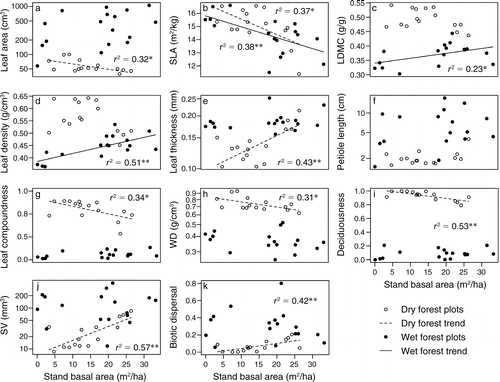 of Mexico. We hypothesized that compositional changes during succession in dry forest were mainly determined by increasing water availability leading to community functional changes from conservative to acquisitive strategies, and in wet forest by decreasing light availability leading to changes from acquisitive to conservative strategies. Research was carried out in 15 dry secondary forest plots (5–63 years after abandonment) and 17 wet secondary forest plots (<1–25 years after abandonment). Community-level functional traits were represented by community-weighted means based on 11 functional traits measured on 132 species. Successional changes in functional composition are more marked in dry forest than in wet forest and largely characterized by different traits. During dry forest succession, conservative traits related to drought tolerance and drought avoidance decreased, as predicted. Unexpectedly acquisitive leaf traits also decreased, whereas seed size and dependence on biotic dispersal increased. In wet forest succession, functional composition changed from acquisitive to conservative leaf traits, suggesting light availability as the main driver of changes. Distinct suites of traits shape functional composition changes in dry and wet forest succession, responding to different environmental filters.
of Mexico. We hypothesized that compositional changes during succession in dry forest were mainly determined by increasing water availability leading to community functional changes from conservative to acquisitive strategies, and in wet forest by decreasing light availability leading to changes from acquisitive to conservative strategies. Research was carried out in 15 dry secondary forest plots (5–63 years after abandonment) and 17 wet secondary forest plots (<1–25 years after abandonment). Community-level functional traits were represented by community-weighted means based on 11 functional traits measured on 132 species. Successional changes in functional composition are more marked in dry forest than in wet forest and largely characterized by different traits. During dry forest succession, conservative traits related to drought tolerance and drought avoidance decreased, as predicted. Unexpectedly acquisitive leaf traits also decreased, whereas seed size and dependence on biotic dispersal increased. In wet forest succession, functional composition changed from acquisitive to conservative leaf traits, suggesting light availability as the main driver of changes. Distinct suites of traits shape functional composition changes in dry and wet forest succession, responding to different environmental filters.
On the hope for biodiversity-friendly tropical landscapes
Felipe P.L. Melo, Víctor Arroyo-Rodríguez, Lenore Fahrig, Miguel Martínez-Ramos, Marcelo Tabarelli.
Abstract
With the decreasing affordability of protecting large blocks of pristine tropical forests, ecologists have staked their hopes on the management of human-modified landscapes (HMLs) to conserve tropical biodiversity. Here, we examine key forces affecting the dynamics of HMLs, and propose a framework connecting human disturbances, land use, and prospects for both tropical biodiversity and ecosystem services. We question the forest transition as a worldwide source of new secondary forest; the role played by regenerating (secondary) forest for biodiversity conservation, and the resilience of HMLs. We then offer a conceptual model describing potential successional trajectories among four major landscape types (natural, conservation, functional, and degraded) and highlight the potential implications of our model in terms of research agendas and conservation planning.
Correlations between physical and chemical defences in plants: tradeoffs, syndromes, or just many different ways to skin a herbivorous cat?
Angela T. Moles, Begoña Peco, Ian R. Wallis, William J. Foley, Alistair G. B. Poore, Eric W. Seabloom, Peter A. Vesk, Alejandro J. Bisigato, Lucrecia Cella-Pizarro, Connie J. Clark, Philippe S. Cohen, William K. Cornwell, Will Edwards, Rasmus Ejrnæs, Therany Gonzales-Ojeda, Bente J. Graae, Gregory Hay, Fainess C. Lumbwe, Benjamín Magaña-Rodríguez, Ben D. Moore, Pablo L. Peri, John R. Poulsen, James C. Stegen, Ruan Veldtman, Hugo von Zeipel, Nigel R. Andrew, Sarah L. Boulter, Elizabeth T. Borer, Johannes H. C. Cornelissen, Alejandro G. Farji-Brener, Jane L. DeGabriel, Enrique Jurado, Line A. Kyhn, Bill Low, Christa P. H. Mulder, Kathryn Reardon-Smith, Jorge Rodríguez-Velázquez, An De Fortier, Zheng Zheng, Pedro G. Blendinger, Brian J. Enquist, Jose M. Facelli, Tiffany Knight, Jonathan D. Majer, Miguel Martínez-Ramos, Peter McQuillan, Francis K. C. Hui
Short summary
Most plant species have a range of traits that deter herbivores. However, understanding of how different defences are 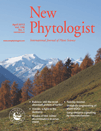 related to one another is surprisingly weak. Many authors argue that defence traits trade off against one another, while others argue that they form coordinated defence syndromes. We collected a dataset of unprecedented taxonomic and geographic scope (261 species spanning 80 families, from 75 sites across the globe) to investigate relationships among four chemical and six physical defences. Five of the 45 pairwise correlations between defence traits were significant and three of these were tradeoffs. The relationship between species’ overall chemical and physical defence levels was marginally nonsignificant (P =0.08), and remained nonsignificant after accounting for phylogeny, growth form and abundance. Neither categorical principal component analysis (PCA) nor hierarchical cluster analysis supported the idea that species displayed defence syndromes. Our results do not support arguments for tradeoffs or for coordinated defence syndromes. Rather, plants display a range of combinations of defence traits. We suggest this lack of consistent defence syndromes may be adaptive, resulting from selective pressure to deploy a different combination of defences to coexisting species.
related to one another is surprisingly weak. Many authors argue that defence traits trade off against one another, while others argue that they form coordinated defence syndromes. We collected a dataset of unprecedented taxonomic and geographic scope (261 species spanning 80 families, from 75 sites across the globe) to investigate relationships among four chemical and six physical defences. Five of the 45 pairwise correlations between defence traits were significant and three of these were tradeoffs. The relationship between species’ overall chemical and physical defence levels was marginally nonsignificant (P =0.08), and remained nonsignificant after accounting for phylogeny, growth form and abundance. Neither categorical principal component analysis (PCA) nor hierarchical cluster analysis supported the idea that species displayed defence syndromes. Our results do not support arguments for tradeoffs or for coordinated defence syndromes. Rather, plants display a range of combinations of defence traits. We suggest this lack of consistent defence syndromes may be adaptive, resulting from selective pressure to deploy a different combination of defences to coexisting species.
Radial Gradients in Wood Specific Gravity, Water and Gas Content in Trees of a Mexican Tropical Rain Forest
Elisabeth Schüller, Miguel Martínez-Ramos, Peter Hietz
Abstract
Cell walls, water, and gas that have mechanical and physiological functions in wood, and wood specific gravity (WSG) is 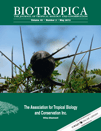 related to demographic traits. To understand variation in wood structure and function, we analyzed radial changes in WSG, in the gas and the water fractions from trees growing in four different habitats in a southern Mexican rain forest. Mean WSG was 0.55 ± 0.16, slightly lower than reported for other tropical forests. In 27 species, WSG decreased and in two species, it increased from pith to bark with a strong (r2 = 0.65) negative correlation between WSG in the center of the tree and the radial WSG gradient. Habitat had some effect on mean WSG and trees growing on karst had significantly higher WSG than the same species growing on alluvial soil. The cell wall, water, and gas fractions accounted for 35 percent (range: 16–50), 42 percent (28–65), and 23 percent (2–56), respectively, of wood volume, with a negative correlation between the gas and the cell wall and between the gas and the water fractions, but not between the cell wall and water fractions. Radially increasing WSG is advantageous for pioneer trees with fast initial growth. We found that the water displacement method may result in biased WSG estimates. To increase the accuracy of WSG data, we suggest to measure sample volume geometrically using a constant diameter (that of the borer tip), to include radial variation in WSG, and to consider for possible site effects on species-specific WSG.
related to demographic traits. To understand variation in wood structure and function, we analyzed radial changes in WSG, in the gas and the water fractions from trees growing in four different habitats in a southern Mexican rain forest. Mean WSG was 0.55 ± 0.16, slightly lower than reported for other tropical forests. In 27 species, WSG decreased and in two species, it increased from pith to bark with a strong (r2 = 0.65) negative correlation between WSG in the center of the tree and the radial WSG gradient. Habitat had some effect on mean WSG and trees growing on karst had significantly higher WSG than the same species growing on alluvial soil. The cell wall, water, and gas fractions accounted for 35 percent (range: 16–50), 42 percent (28–65), and 23 percent (2–56), respectively, of wood volume, with a negative correlation between the gas and the cell wall and between the gas and the water fractions, but not between the cell wall and water fractions. Radially increasing WSG is advantageous for pioneer trees with fast initial growth. We found that the water displacement method may result in biased WSG estimates. To increase the accuracy of WSG data, we suggest to measure sample volume geometrically using a constant diameter (that of the borer tip), to include radial variation in WSG, and to consider for possible site effects on species-specific WSG.
Selecting Species for Passive and Active Riparian Restoration in Southern Mexico
Paula Meli, Miguel Martínez-Ramos, José M. Rey-Benayas
Abstract
In revegetation projects, distinguishing species that can be passively restored by natural regeneration from those requiring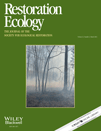 active restoration is not a trivial decision. We quantified tree species dominance (measured by an importance value index, IVIi) and used abundance–size correlations to select those species suitable for passive and/or active restoration of disturbed riparian vegetation in the Lacandonia region, Southern Mexico. We sampled riparian vegetation in a 50 × 10–m transect in each of six reference (RE) and five disturbed (DE) riparian ecosystems. Those species representing more than 50% of total IVI in each ecosystem were selected, and Spearman rank correlation between abundance and diameter classes was calculated. For eight species, it was determined that passive restoration could be sufficient for their establishment. Another eight species could be transplanted by means of active restoration. Five species regenerate well in only one ecosystem type, suggesting that both restoration strategies could be used depending on the degree of degradation. Finally, two species were determined to not be suitable for restoration in the RE (based on the above selection criteria) and were not selected during this initial stage of our restoration project. The high number of tree species found in the RE suggests that the species pool for ecological restoration is large. However, sampling in both ecosystem types helped us reduce the number of species that requires active restoration. Restoration objectives must guide the selection of which methods to implement; in different conditions, other criteria such as dispersal syndrome or social value could be considered in the species selection.
active restoration is not a trivial decision. We quantified tree species dominance (measured by an importance value index, IVIi) and used abundance–size correlations to select those species suitable for passive and/or active restoration of disturbed riparian vegetation in the Lacandonia region, Southern Mexico. We sampled riparian vegetation in a 50 × 10–m transect in each of six reference (RE) and five disturbed (DE) riparian ecosystems. Those species representing more than 50% of total IVI in each ecosystem were selected, and Spearman rank correlation between abundance and diameter classes was calculated. For eight species, it was determined that passive restoration could be sufficient for their establishment. Another eight species could be transplanted by means of active restoration. Five species regenerate well in only one ecosystem type, suggesting that both restoration strategies could be used depending on the degree of degradation. Finally, two species were determined to not be suitable for restoration in the RE (based on the above selection criteria) and were not selected during this initial stage of our restoration project. The high number of tree species found in the RE suggests that the species pool for ecological restoration is large. However, sampling in both ecosystem types helped us reduce the number of species that requires active restoration. Restoration objectives must guide the selection of which methods to implement; in different conditions, other criteria such as dispersal syndrome or social value could be considered in the species selection.
Vegetation recovery and plant facilitation in a human-disturbed lava field in a megacity: searching tools for ecosystem restoration
Pedro E. Mendoza-Hernández, Alma Orozco-Segovia, Jorge A. Meave, Teresa Valverde, Miguel Martínez-Ramos
Abstract
Unplanned urban development threatens natural ecosystems. Assessing ecosystem recovery after anthropogenic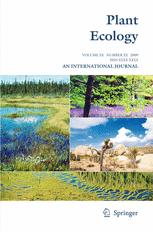 disturbances and identifying plant species that may facilitate vegetation regeneration are critical for the conservation of biodiversity and ecosystem services in urban areas. At the periphery of Mexico City, illegal human settlements produced different levels of disturbance on natural plant communities developed on a lava field near the Ajusco mountain range. We assessed natural regeneration of plant communities 20 years after the abandonment of the settlements, in sites that received low (manual harvesting of non-timber forest products), medium (removal of aboveground vegetation), and high (removal of substrate and whole vegetation) disturbance levels. We also tested the potential facilitative role played by dominant tree and shrub species. Plant diversity and vegetation biomass decreased as disturbance level increased. Sites with high disturbance level showed poor regeneration and the lowest species similarity compared to the least disturbed sites. Six dominant species (i.e., those with the highest abundance, frequency, and/or basal area) were common to all sites. Among them, three species (the tree Buddleja cordata, and two shrubs, Ageratina glabrata and Sedum oxypetalum) were identified as potential facilitators of community regeneration, because plant density and species richness were significantly higher under their canopies than at open sites. We propose that analyzing community structural traits of the successional vegetation (such as species diversity and biomass) and identifying potential facilitator species are useful steps in assessing the recovery ability of plant communities to anthropogenic disturbances, and in designing restoration strategies.
disturbances and identifying plant species that may facilitate vegetation regeneration are critical for the conservation of biodiversity and ecosystem services in urban areas. At the periphery of Mexico City, illegal human settlements produced different levels of disturbance on natural plant communities developed on a lava field near the Ajusco mountain range. We assessed natural regeneration of plant communities 20 years after the abandonment of the settlements, in sites that received low (manual harvesting of non-timber forest products), medium (removal of aboveground vegetation), and high (removal of substrate and whole vegetation) disturbance levels. We also tested the potential facilitative role played by dominant tree and shrub species. Plant diversity and vegetation biomass decreased as disturbance level increased. Sites with high disturbance level showed poor regeneration and the lowest species similarity compared to the least disturbed sites. Six dominant species (i.e., those with the highest abundance, frequency, and/or basal area) were common to all sites. Among them, three species (the tree Buddleja cordata, and two shrubs, Ageratina glabrata and Sedum oxypetalum) were identified as potential facilitators of community regeneration, because plant density and species richness were significantly higher under their canopies than at open sites. We propose that analyzing community structural traits of the successional vegetation (such as species diversity and biomass) and identifying potential facilitator species are useful steps in assessing the recovery ability of plant communities to anthropogenic disturbances, and in designing restoration strategies.
Selecting Species for Passive and Active Riparian Restoration in Southern Mexico (Restoration Ecology DOI: 10.1111/j.1526-100X.2012.00934.x.)
Meli, P., M. Martínez-Ramos & José M. Rey-Benayas
Abstract
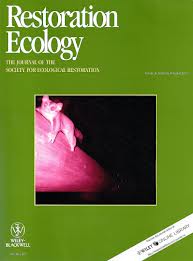 In revegetation projects, distinguishing species that can be passively restored by natural regeneration from those requiring active restoration is not a trivial decision. We quantified tree species dominance (measured by an importance value index, IVIi) and used abundance–size correlations to select those species suitable for passive and/or active restoration of disturbed riparian vegetation in the Lacandonia region, Southern Mexico. We sampled riparian vegetation in a 50×10–m transect in each of six reference (RE) and five disturbed (DE) riparian ecosystems. Those species representing more than 50% of total IVI in each ecosystem were selected, and Spearman rank correlation between abundance and diameter classes was calculated.
In revegetation projects, distinguishing species that can be passively restored by natural regeneration from those requiring active restoration is not a trivial decision. We quantified tree species dominance (measured by an importance value index, IVIi) and used abundance–size correlations to select those species suitable for passive and/or active restoration of disturbed riparian vegetation in the Lacandonia region, Southern Mexico. We sampled riparian vegetation in a 50×10–m transect in each of six reference (RE) and five disturbed (DE) riparian ecosystems. Those species representing more than 50% of total IVI in each ecosystem were selected, and Spearman rank correlation between abundance and diameter classes was calculated.
Manejo de Ecosistemas en Paisajes Rurales (Investigación Ambiental, ciencia y Política pública 4(2))
Miguel Martínez-Ramos, Juan Dupuy Rada y Julieta Benítez-Malvido
Presentación
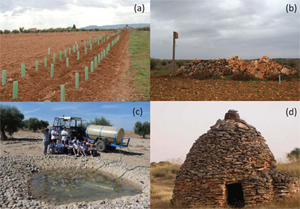 El enorme crecimiento de la población humana, de la economía y del consumo acaecido durante los últimos 70 años ha llevado a una igualmente creciente demanda de alimentos agrícolas y pecuarios. Para cubrir esta demanda, se han convertido grandes extensiones de ecosistemas naturales de regiones frías, templadas, áridas y tropicales en campos agropecuarios a nivel mundial. Se estima que más de un tercio de la superficie terrestre del planeta se dedica al uso agrícola y pecuario (MEA 2005). En México, cerca del 70% de la superficie terrestre ha sido afectado por tal uso (FAO 2009) de tal manera que la mayoría de los ecosistemas del país han sido alterados en mayor o menor medida por las actividades agropecuarias (Sánchez-Colón et al. 2008).
El enorme crecimiento de la población humana, de la economía y del consumo acaecido durante los últimos 70 años ha llevado a una igualmente creciente demanda de alimentos agrícolas y pecuarios. Para cubrir esta demanda, se han convertido grandes extensiones de ecosistemas naturales de regiones frías, templadas, áridas y tropicales en campos agropecuarios a nivel mundial. Se estima que más de un tercio de la superficie terrestre del planeta se dedica al uso agrícola y pecuario (MEA 2005). En México, cerca del 70% de la superficie terrestre ha sido afectado por tal uso (FAO 2009) de tal manera que la mayoría de los ecosistemas del país han sido alterados en mayor o menor medida por las actividades agropecuarias (Sánchez-Colón et al. 2008).
Manejo de bosques tropicales: bases científicas para la conservación, restauración y aprovechamiento de ecosistemas en paisajes rurales. Investigación Ambiental, ciencia y Política pública 4(2).
Miguel Martínez-Ramos, Laura Barraza, Patricia Balvanera, Julieta Benítez-Malvido, Frans Bongers, Alicia Castillo Álvarez, Alfredo D. Cuarón, Guillermo Ibarra-Manríquez, Horacio Paz-Hernández, Alfredo Pérez-Jiménez, Mauricio Quesada Avendaño, Diego R. Pérez-Salicrup, G. Arturo Sánchez-Azofeifa, Jorge E. Schondube, Kathryn Stoner, Javier Alvarado Díaz, Karina Boege, Ek del-Val, Mario E. Favila Carrillo, Ireri Suazo-Ortuño, Luis Daniel Ávila-Cabadilla, Mariana Yólotl Álvarez Añorve, Margarita Cano Ramírez, Jessica Castillo Mandujano, Oscar Chaves Badilla, Erika I. de la Peña, Alejandra Corzo Domínguez, María del Carmen Godínez Gutiérrez, Adriana P. Gómez Bonilla, Ana Ma. González Di Pierro, Beatriz Fuentealba Durán, Waleeha A. Gudiño González, Omar Hernández Ordoñez, Margaret Kaláscka, Madelon Lobeck, Antonio López-Carretero, César Manrique Ascencio, Susana Maza-Villalobos, Moisés Méndez-Toribio, Francisco Mora-Ardila, Carlos Muench Spitzer, Cristina B. Peñaloza Guerrero, Luisa F. Pinzón Pérez, Ma. Elena Páramo Pérez, Fernando Pineda García, Arlette Ricaño Rocha, Maya Rocha Ortega, Jorge Rodríguez-Velázquez, Natalia Mariel Schroeder, Jenny Trilleras-Motha, Michiel Van Breugel, Peter Van der Sleen, Edith Villa Galaviz, Isela Zermeño Hernández.
Resumen
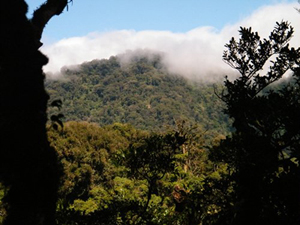 Presentamos una síntesis del programa de investigación de largo plazo (iniciado en 2004) denominado Manejo de Bosques Tropicales (MABOTRO), llevado a cabo por académicos de once instituciones y más de 50 estudiantes de licenciatura y posgrado. Se construyó un marco metodológico para la generación de conocimientos que coadyuve a la preservación de selvas, a la restauración de campos degradados y al uso de selvas secundarias, todo ello en el contexto de la conservación de la biodiversidad y el mantenimiento de servicios ecosistémicos en paisajes agropecuarios. El programa incluye módulos de investigación ecológica y social efectuados en dos localidades contrastantes: la región de Chamela (selva seca), en la costa del Pacífico de Jalisco, y la región Lacandona (selva húmeda), al este de Chiapas; ambas regiones han sido ocupadas por comunidades ejidales desde hace poco más de cuatro décadas. Leer Mas
Presentamos una síntesis del programa de investigación de largo plazo (iniciado en 2004) denominado Manejo de Bosques Tropicales (MABOTRO), llevado a cabo por académicos de once instituciones y más de 50 estudiantes de licenciatura y posgrado. Se construyó un marco metodológico para la generación de conocimientos que coadyuve a la preservación de selvas, a la restauración de campos degradados y al uso de selvas secundarias, todo ello en el contexto de la conservación de la biodiversidad y el mantenimiento de servicios ecosistémicos en paisajes agropecuarios. El programa incluye módulos de investigación ecológica y social efectuados en dos localidades contrastantes: la región de Chamela (selva seca), en la costa del Pacífico de Jalisco, y la región Lacandona (selva húmeda), al este de Chiapas; ambas regiones han sido ocupadas por comunidades ejidales desde hace poco más de cuatro décadas. Leer Mas
Abstract
We present a synthesis of the long-term research program (started in 2004) Tropical Forest Management (MABOTRO), conducted by academics of eleven institutions and more than 50 bachelor and graduate students. We built a methodological framework for the generation of knowledge useful for the preservation of tropical forests, the restoration of degraded areas and the use of secondary forests, all within the context of the conservation of biodiversity and ecosystem services in agricultural landscapes. The program includes modules of ecological and social research conducted in two contrasting locations: Chamela region (tropicaldry forest), on the Pacific coast of Jalisco, and the Lacandon region (tropical rain forest), at east of Chiapas; the two regions have been occupied by ejido communities for a little more than four decades. Read more
Defoliation and gender effects on fitness components in three congeneric and sympatric undestorey palms (Journal of Ecology 100: 1544-1556)
Juan C. Hernández-Barrios, Niels P. R. Anten, David D. Ackerly, Miguel Martínez-Ramos
Short summary
Using three dioecious understorey palm (Chamaedorea) species, we tested the hypothesis that females are less tolerant than males to increased levels of sustained defoliation. Results did not support the hypothesis as life-history and functional trait effects of defoliation were mostly similar between genders. We discuss the ecological implications of these results and their importance for designing sustainable leaf harvesting regimes.
The three Chamaedorea species studied at Southeastern Mexico. Chamaedorea elegans is the smallest species (maximum height 1.5 m) and C. oblongata the bigger one (maxim height 4 m).
Resilience to chronic defoliation in a dioecious understorey tropical rain forest palm (Journal of Ecology 100: 1245-1256)
Leonel Lopez-Toledo, Niels P.R. Anten, Bryan A. Endress, David D. Ackerly, Miguel Martínez-Ramos
Graphical abstract
Increased levels of chronic experimental defoliation, applied every six months over three years, in Chamaedorea elegans palms concomitantly reduced survival, growth, and reproduction depending on gender. After stopped defoliation, recovery of vital rates observed over the following three years was slower in females than males. The lower resilience shown by females to defoliation may have profound long-lasting consequences for the dynamics and genetic variability of palm populations undergoing prolonged defoliation. Such effects may be aggravated by the incidence of severe drought episodes caused by El Nino Southern-Oscillation (ENSO) events, which are expected to increase in frequency according to global climate change predictions.
